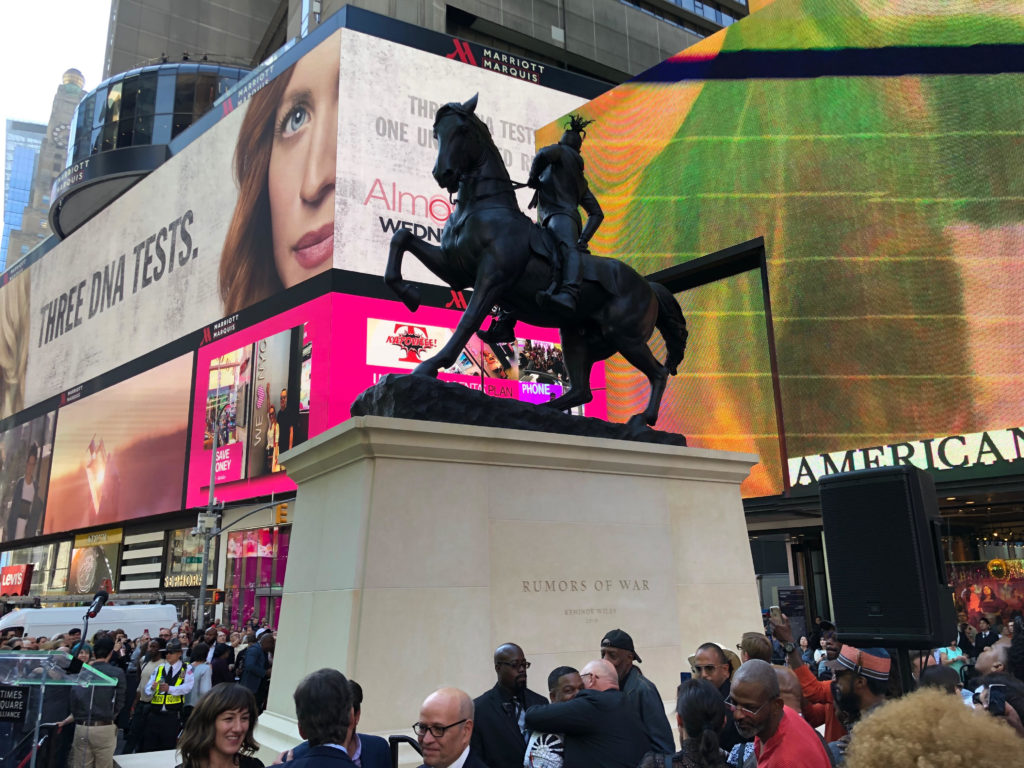[ad_1]

Kehinde Wiley, Rumors of War (2019), installed in Times Square. Below, the artist embraces his gallerist Sean Kelly.
ANNIE ARMSTRONG/ARTNEWS
On Friday afternoon, amid the chaos of New York’s Times Square, a very calm and well-dressed group of people congregated near 46th Street and 8th Avenue beneath a looming abstract shape shrouded by a silver cloth. What hid beneath was Rumors of War, a new sculpture by Kehinde Wiley, but no one had yet seen it.
Champagne was passed around to attendees including Thelma Golden from the Studio Museum in Harlem, gallerist Sean Kelly, writer Antwaun Sargent, and Tom Finkelpearl, commissioner of the New York City Department of Cultural Affairs. (Whispers got around that Barack Obama, who chose Kehinde Wiley to paint his Presidential likeness for the National Portrait Gallery, might make an appearance, though sadly he did not).
Suddenly, a marching band rolled in, their yellow-and-black costumes revealing their origins from Malcolm X Shabazz High School in Newark, New Jersey, amid chants of “Let’s go! Let’s go!” Wiley himself then appeared in front of the grey monolith, looking larger than life in a colorful suit, and began to dance.
“We thank Kehinde for making this day a day of rebirth,” Alex Nyerges, the director of the Virginia Museum of Fine Arts, said to the assembled in a thick southern drawl. The museum a few states away had already acquired the mystery work—which was still in hiding—after a unanimous vote from its board, and board chair Monroe E. Harris added, “From the slave ship to the board room, we have made progress. Look at this crowd. This is the most important acquisition this museum has ever made.”
Richmond, the Virginia Museum’s home, is also home to 10 Confederate statues still standing in the city. “That’s 10 too many,” Levar Stoney, Richmond’s mayor, said.
When the drape was lifted and the monument was revealed, the sculpture—of a young black man wearing a hoodie and sporting dreadlocks astride a horse going to battle, his Nikes driving hard into stirrups—was greeted by a mix of gasps and applause. In an earlier description of the piece—which is being shown in New York by Times Square Arts along with the Virginia Museum of Fine Arts and Sean Kelly Gallery through December 1—the artist said, “Rumors of War attempts to use the language of equestrian portraiture to both embrace and subsume the fetishization of state violence.” In front of the audience, he said, “Human nature is to have war. Human nature is to have strife. The nature of human beings is to be in moments politically and socially like the one right now, but there’s nothing new to that. And we’re stronger than it.”
Wiley came up with the idea for the piece after visiting Richmond three years ago and walking down Monument Avenue, which is lined with Confederate statues. “What does it feel like physically to walk a public space and to have your state, your country, your nation say, ‘This is what we stand by’?” he asked the audience, exasperated. “We want more. We demand more. We creative people need to create more.”
Looking choked up, Wiley continued: “We come from a beautiful, fractured, sometimes terrible past. But I think the job of artists is to be able to take all those myriad pieces [and] imagine them coming back together, to be able to look at yourself—your black body, your female body, your trans body, whoever you happen to be—to be able to see yourself in this place that we call America.”
[ad_2]
Source link

